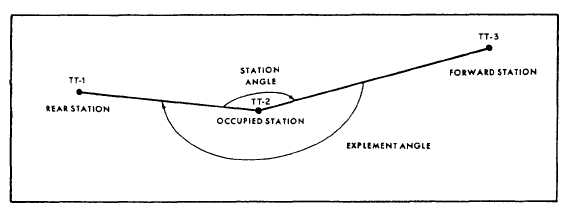easy. If you do not find the adjacent station easily,
you should observe an astronomic azimuth to
orient the starting line, and then continue the
traverse. Any existing control near the traverse
line should be tied in to the new work.
PERFORMING LINEAR
MEASUREMENTS
As traversing progresses, linear measurements
are conducted to determine the distance between
stations or points. Generally, the required traverse
accuracy will determine the type of equipment and
the method of measuring the distance. For the
lower orders, a single taped distance is sufficient.
However, as the order of accuracy gets higher,
DOUBLE TAPING (once each way) is required.
Ordinary steel tapes must be compared to an
Invar or Lovar tape at specified intervals. For the
highest accuracy, electronic distance-measuring
devices (EDM) are used to measure linear
distances. Linear measurements may also be made
by indirect methods, using an angle measuring
instrument, like the transit or theodolite with
stadia. When the distances are determined by
stadia readings, the vertical angles are read and
used to convert slope distances to horizontal
distances.
If double taping or chaining is required, follow
these procedures:
1. Follow a direct line between stations, using
a guide, such as a transit and a range pole, for
alignment. Start measuring from the occupied
station, keeping the front end of the tape aligned
with the forward station.
2. Start back from the forward station,
using the same alignment but not the same
taping points. The second measurement must be
independent of the first.
3. Compare the two distances, and if within
accuracy requirements, the distance is accepted.
If the two measurements disagree by more than
the allowable amount, retape the distance.
4. Proceed to the next line measurement, and
continue double taping until the tie-in control
point is reached.
PERFORMING ANGULAR
MEASUREMENT
Horizontal angles formed by the lines of each
traverse station determine the relative directions
of the traverse lines. These angles are measured
using a transit or a theodolite, or determined
graphically with a plane table and alidade. In a
traverse, three traverse stations are significant: the
REAR STATION, the OCCUPIED STATION,
and the FORWARD STATION (fig. 13-30). The
rear station is that station from which the crew
performing the traverse has just moved, or it is
a point, the azimuth to which is known. The
occupied station is the station at which the crew
is now located and over which the surveying
instrument is set. The forward station is the next
station in succession and constitutes the immediate
destination of the crew. The stations are
numbered consecutively starting at Number 1 and
continuing throughout the traverse. In addition
to the number of station, an abbreviation
indicating the type of traverse is oftentimes
Figure 13-30.-Traverse stations and angles.
13-29

